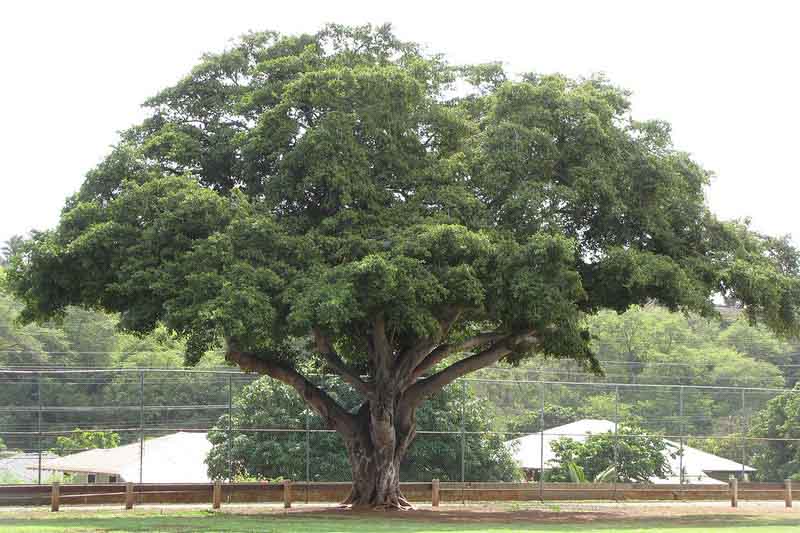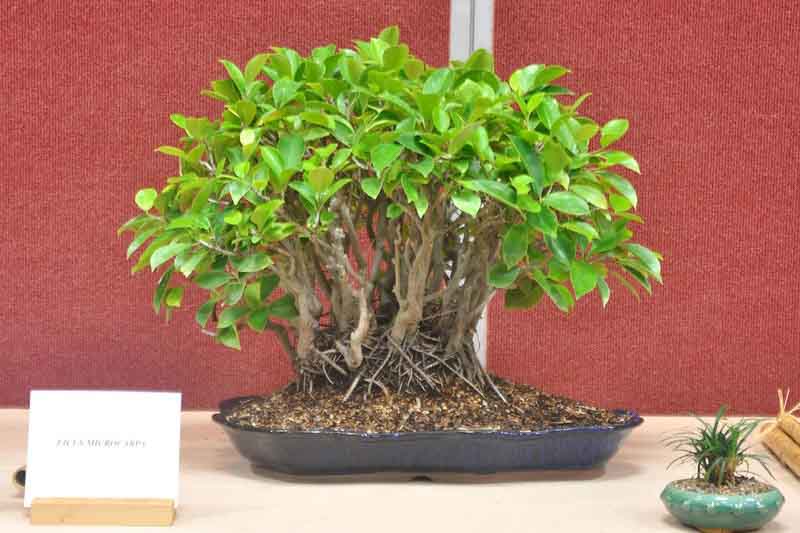Chinese Banyan, Malayan Banyan, Indian Laurel, Curtain Fig, Gajumaru
Ficus microcarpa, also known as Chinese Banyan or Indian Laurel Fig, is a tropical tree renowned for its lush foliage and distinctive growth pattern.
Native: Native to Asia and Australia, it’s commonly found in countries like India, China, Malaysia, and Australia. It is widely planted as a shade tree. Chinese Banyan belongs to the mulberry and fig family Moraceae.
Plant Type and Habit: This fig species is an evergreen tree with a robust, tropical growth habit characterized by a dense canopy of glossy, dark green leaves and a thick, gnarled trunk often adorned with aerial roots. In its natural habitat, it grows as a large, spreading tree, but when cultivated indoors or as bonsai, it adapts to a much smaller, manageable form, making it a versatile choice for various landscaping and indoor decor styles.
Size: In its natural habitat, the Chinese Banyan can grow into a substantial tree, reaching impressive heights of up to 100 feet (30 meters) with a wide, spreading canopy that can extend equally broad. In Mediterranean climates, it typically grows to about 40 feet (12 meters) tall and with an equal spread of the crown. However, when cultivated as an indoor plant or bonsai, it typically achieves a manageable size, ranging from 2 to 10 feet (60-300 cm) in height, depending on the pot size and pruning.
Flowers and Fruits: The Chinese Banyan produces inconspicuous flowers, as they are hidden inside the small, inedible, green to reddish figs.
Foliage: Features dense, glossy, dark green leaves that are oval-shaped and can grow up to 2 inches (5 cm) long.
Bark: The bark is smooth and gray, contributing to the tree’s ornamental value.
Uses: Chinese Banyan is widely used for ornamental purposes in landscaping and as a popular indoor plant. Its dense canopy makes it an excellent shade tree in urban environments. Additionally, it’s commonly utilized in the art of bonsai due to its versatile and attractive foliage and distinctive aerial roots.
Hardiness: It’s hardy in USDA zones 9-11 and prefers a warm, humid climate.
Toxicity: The Chinese Banyan contains a sap that is toxic to pets and humans when ingested. The sap irritates the mouth and stomach. Contact with its sap can also lead to skin irritation for some individuals.
Invasiveness: Ficus microcarpa has become invasive in regions like Hawaii, Florida, Bermuda, French Polynesia, Guam, the Bonin Islands, and parts of the West Indies, Central, and South America. It produces numerous viable seeds spread by birds and animals. These seeds flourish in diverse conditions, enabling the plant to outcompete native flora. Initially an epiphyte, it strangles host plants with its aerial roots, later dominating with its large, dense canopy.
Benefits: Provides shade and improves air quality. Its dense foliage is effective for noise reduction in urban settings.

Caring for the Chinese Banyan or Ginseng Ficus, especially when grown indoors, involves several key factors to ensure its health and growth:
Lighting: Prefers bright, indirect sunlight. Place it near a window where it can receive plenty of light but avoid direct sunlight, which can scorch its leaves.
Watering: Water when the top inch of soil becomes dry. Overwatering can lead to root rot, so ensure good drainage. The watering frequency will depend on the humidity and temperature of your home.
Temperature and Humidity: Keep your Ficus in a warm environment, ideally between 60-75°F (15-25°C). Avoid placing it in drafty areas or near air conditioning vents. This species thrives in a humid environment. If your indoor air is dry, especially in winter, consider using a humidifier or placing the plant’s pot on a tray of watered pebbles to increase humidity.
Soil and Repotting: Use a well-draining potting mix. A standard houseplant or bonsai soil mix works well for Ficus microcarpa. Repot every two to three years to refresh the soil and to accommodate the plant’s growing root system.
Fertilizing: Feed your plant with a balanced, water-soluble fertilizer every month during the growing season (spring and summer). Reduce feeding in the fall and winter when growth slows down.
Pruning and Cleaning: Prune to maintain its shape and size and to encourage bushier growth. This is especially important if you’re growing it as a bonsai.
Caring for Ficus microcarpa outdoors requires consideration of its natural habitat and how those conditions can be replicated or accommodated in your garden. Here are key points for outdoor care:
Climate Suitability: Ficus microcarpa thrives in warm, humid climates, typically USDA hardiness zones 9-11. In cooler regions, it may need protection from frost and could be grown in a pot to bring indoors during colder months.
Sunlight: t prefers bright, indirect sunlight. In very hot climates, partial shade, especially during the hottest part of the day, can prevent leaf scorch. In cooler areas, maximize sunlight exposure to ensure sufficient warmth and light.
Watering: The tree should be watered regularly, allowing the soil to dry out slightly between waterings. Overwatering or poor drainage can lead to root rot. Adjust watering based on rainfall, temperature, and humidity.
Soil: Ficus microcarpa does well in humus-rich, well-draining soil. It’s adaptable to a range of soil types but prefers a slightly acidic to neutral pH.
Fertilizing: Apply a balanced fertilizer during the growing season (spring and summer) to support growth. Reduce feeding in the fall and winter.
Pruning: Prune to shape the tree and control its size. It can be quite vigorous, so regular pruning may be necessary. Remove any dead or diseased branches to maintain plant health.
Mulching: Applying mulch around the base can help retain soil moisture and reduce temperature fluctuations.

Ficus microcarpa, like many plants, can be susceptible to certain pests, diseases, and common problems, especially when its growing conditions are not ideal.
Aphids: They are small, sap-sucking insects, often green or black, which cluster on new growth and undersides of leaves. They excrete sticky honeydew, leading to sooty mold. Treatment includes washing them off with water or using insecticidal soap.
Spider mites: These tiny pests can cause yellowing or speckling on leaves. You may also see fine webs. Increase humidity around the plant and wipe the leaves with a damp cloth. If infestation persists, use insecticidal soap or neem oil.
Mealybugs: These small, white, cottony pests suck sap from the leaves, weakening the plant. They can be removed with a cotton swab dipped in rubbing alcohol or treated with insecticidal soap.
Scale insects: These look like small, brown, bumpy spots on stems and leaves. They can be scraped off gently or treated with neem oil or insecticidal soap.
Root rot: Overwatering can lead to root rot, a serious condition that can kill the plant. Signs include yellowing leaves, wilting, and a musty smell from the soil. Prevent it by ensuring proper drainage and allowing the soil to dry between waterings.
Leaf spot: This can be caused by either fungal or bacterial infections, leading to brown or black spots on the leaves. Improve air circulation, avoid wetting the leaves, and remove affected leaves. Fungicide or bactericide may be needed in severe cases.
Gray mold or botrytis: A fungal disease that causes gray mold on leaves, especially in cool, damp conditions. Improve air circulation, reduce humidity, and remove affected parts. Fungicides can be used for severe infections, and preventive care is crucial.
Leaf Drop: Sudden changes in temperature, light, or watering can cause Ficus microcarpa to shed leaves.
Yellowing Leaves: Overwatering, poor drainage, or nutrient deficiencies can lead to yellowing leaves.

Is Ficus microcarpa a Good Indoor Plant?
Yes, Ficus microcarpa, also known as Chinese Banyan or Ginseng Ficus, is a popular indoor plant. It’s valued for its aesthetic appeal, robust nature, and adaptability to indoor conditions. Its ability to thrive in indoor environments with appropriate care makes it a favored choice among houseplant enthusiasts.
How big does a Ficus microcarpa get?
The Chinese Banyan, in its natural setting, can tower up to 100 feet (30 meters), boasting an expansive canopy. In Mediterranean climates, it often reaches 40 feet (12 meters) in height and width. As an indoor plant or bonsai, its growth is significantly limited, usually spanning 2 to 10 feet (60-300 cm) tall, influenced by pot size and pruning practices, making it adaptable for various indoor and outdoor environments.
What are the benefits of the Ficus microcarpa tree?
The Ficus microcarpa tree offers several benefits: it’s an effective air purifier, removing indoor pollutants; its lush foliage enhances aesthetic appeal and contributes to stress reduction in indoor environments. Additionally, its robust nature makes it adaptable as a bonsai or landscape feature. This tree supports urban greening efforts and provides ecological benefits by offering habitat and food for various bird species.
| Hardiness |
9 - 11 |
|---|---|
| Climate Zones | 9, 13, 16, 17, 19, 20, 21, 22, 23, 24, H1, H2 |
| Plant Type | Houseplants, Trees |
| Plant Family | Moraceae |
| Genus | Ficus |
| Exposure | Full Sun, Partial Sun |
| Season of Interest |
Spring (Early, Mid, Late) Summer (Early, Mid, Late) Fall Winter |
| Height |
2' - 100' (60cm - 30.5m) |
| Spread |
2' - 100' (60cm - 30.5m) |
| Maintenance | Low |
| Water Needs | Average |
| Soil Type | Loam, Chalk, Clay, Sand |
| Soil pH | Acid, Alkaline, Neutral |
| Soil Drainage | Moist but Well-Drained |
| Characteristics | Showy, Evergreen |
| Garden Uses | Beds And Borders, Patio And Containers |
| Garden Styles | Mediterranean Garden |
| Hardiness |
9 - 11 |
|---|---|
| Climate Zones | 9, 13, 16, 17, 19, 20, 21, 22, 23, 24, H1, H2 |
| Plant Type | Houseplants, Trees |
| Plant Family | Moraceae |
| Genus | Ficus |
| Exposure | Full Sun, Partial Sun |
| Season of Interest |
Spring (Early, Mid, Late) Summer (Early, Mid, Late) Fall Winter |
| Height |
2' - 100' (60cm - 30.5m) |
| Spread |
2' - 100' (60cm - 30.5m) |
| Maintenance | Low |
| Water Needs | Average |
| Soil Type | Loam, Chalk, Clay, Sand |
| Soil pH | Acid, Alkaline, Neutral |
| Soil Drainage | Moist but Well-Drained |
| Characteristics | Showy, Evergreen |
| Garden Uses | Beds And Borders, Patio And Containers |
| Garden Styles | Mediterranean Garden |
How many Ficus microcarpa (Chinese Banyan) do I need for my garden?
| Plant | Quantity | |
|---|---|---|
| Ficus microcarpa (Chinese Banyan) | N/A | Buy Plants |
Create a membership account to save your garden designs and to view them on any device.
Becoming a contributing member of Gardenia is easy and can be done in just a few minutes. If you provide us with your name, email address and the payment of a modest $25 annual membership fee, you will become a full member, enabling you to design and save up to 25 of your garden design ideas.
Join now and start creating your dream garden!
Create a membership account to save your garden designs and to view them on any device.
Becoming a contributing member of Gardenia is easy and can be done in just a few minutes. If you provide us with your name, email address and the payment of a modest $25 annual membership fee, you will become a full member, enabling you to design and save up to 25 of your garden design ideas.
Join now and start creating your dream garden!